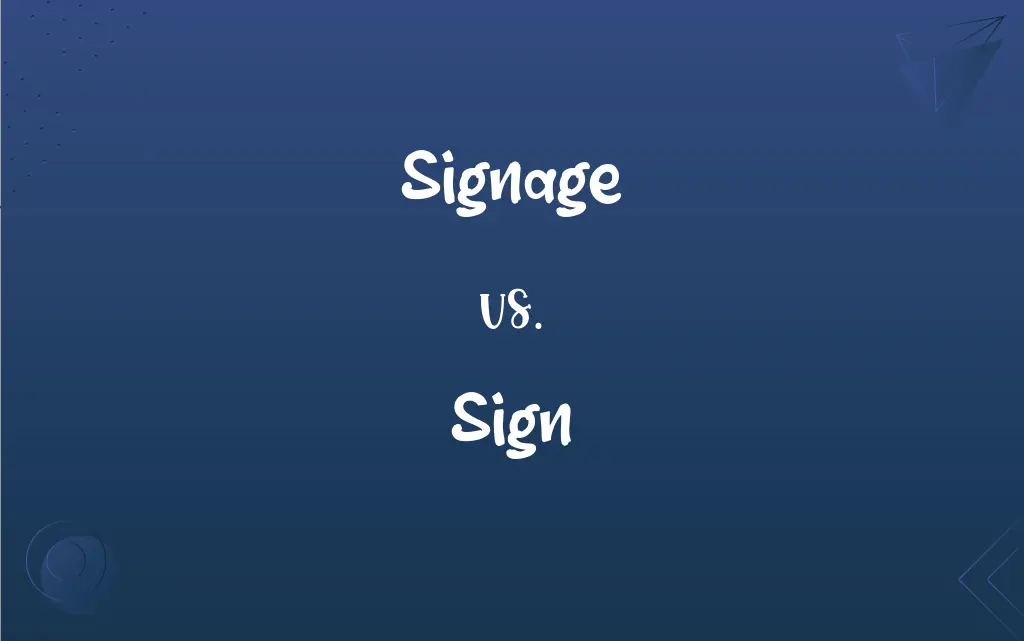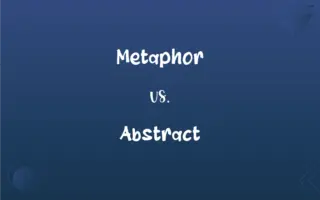Signage vs. Sign: What's the Difference?
Edited by Janet White || By Aimie Carlson || Updated on November 10, 2023
Signage refers to the collective use of signs as a system or group for communication, whereas a sign is an individual symbol, object, or display conveying information or direction.

Key Differences
Signage encompasses a system or collection of signs used for communication, often found in public spaces or businesses to guide or inform. Sign, in contrast, refers to a single display or symbol used to communicate a specific message, direction, or information.
In the context of business, signage refers to the overall strategy of using signs for branding, advertising, or directions within a store or company. A sign is a component of this system, an individual entity conveying a particular piece of information, like a product advertisement or an exit sign.
Signage is often designed with a consistent theme or style to create a unified aesthetic or convey a brand identity. On the other hand, a sign can be standalone and varies widely in design, from road signs to store banners, each serving a unique purpose.
The effectiveness of signage is measured by how well the collection of signs communicates and guides the audience, whereas the effectiveness of a sign is determined by its clarity and ability to convey a specific message.
In urban planning and architecture, signage plays a crucial role in creating navigable and user-friendly environments, while a sign is a tool used within these environments to provide information or instructions to individuals.
ADVERTISEMENT
Comparison Chart
Definition
System of signs for communication
Individual symbol or display
Scope
Collective, strategic use
Single, specific message
Consistency
Often themed or branded
Can be varied and standalone
Purpose
Overall communication and guidance
Conveying a particular piece of information
Role in Environments
Navigational and informational system
Individual informational tool
ADVERTISEMENT
Signage and Sign Definitions
Signage
Branding Tool.
The company updated its signage for a fresher look.
Sign
Directional Indicator.
The exit sign guided us out of the building.
Signage
Collection of Signs.
The store's signage made navigating different sections easy.
Sign
Symbolic Representation.
A stop sign is universally recognized.
Signage
Informational System.
Museum signage provides insights about exhibits.
Sign
Advertising Medium.
A neon sign advertised the diner.
Signage
Navigational Aid.
Airport signage helps passengers find their gates.
Sign
Warning or Alert.
The wet floor sign cautioned visitors.
Signage
Visual Communication.
Effective signage is key to attracting customers.
Sign
Information Provider.
The historical marker is an informative sign.
Signage
Signs considered as a group.
Sign
Something that suggests the presence or existence of a fact, condition, or quality
A high temperature is a sign of fever.
Signage
The design or use of signs and symbols.
Sign
An act or gesture used to convey an idea, a desire, information, or a command
Gave the go-ahead sign.
Signage
(uncountable) Signs, particularly those imparting commercial, directional, or road traffic information, taken collectively.
The signage at the airport is designed to point the way clearly to important locations.
Sign
Sign language.
Signage
A sign, a signboard.
Signage
Signs collectively (especially commercial signs or posters);
There will be signage displayed at each post
FAQs
Can a sign be part of signage?
Yes, individual signs are components of broader signage systems.
What is signage?
A system or collection of signs used for communication and navigation.
Why is signage important in business?
It helps in branding, directing, and informing customers.
What is a sign?
An individual symbol or display that conveys a specific message.
How does signage differ from a sign?
Signage refers to the collective use of signs, while a sign is a single entity.
What role does signage play in safety?
It provides important safety instructions and warnings.
How do I choose the right sign for my business?
Consider your message, brand identity, and the sign's intended location.
Can a sign be non-visual, like audio?
Traditionally, signs are visual, but audio signals can also be considered signs in a broader sense.
What makes a sign effective?
Clarity, visibility, and the ability to convey its intended message.
Are digital displays considered signage?
Yes, digital displays are a modern form of signage.
Is signage only used in businesses?
No, it's also used in public spaces, roads, and educational institutions.
How has digital technology impacted signage?
Digital technology allows for dynamic, easily updateable signage.
Are there legal regulations for signage?
Yes, especially for outdoor signage and signs in public spaces.
Can a single sign constitute signage?
Not usually, as signage implies a collection or system of signs.
What types of materials are used for signs?
Metals, plastics, wood, and digital screens are common materials.
Can signage be both indoor and outdoor?
Yes, there are specific designs for both indoor and outdoor environments.
Can signs be artistic?
Absolutely, many signs incorporate artistic elements for aesthetic appeal.
How does a sign contribute to branding?
A sign can display a brand's logo or message, contributing to brand recognition.
Does signage require maintenance?
Yes, regular maintenance ensures visibility and effectiveness.
What is an example of an informational sign?
A map in a shopping mall is an informational sign.
About Author
Written by
Aimie CarlsonAimie Carlson, holding a master's degree in English literature, is a fervent English language enthusiast. She lends her writing talents to Difference Wiki, a prominent website that specializes in comparisons, offering readers insightful analyses that both captivate and inform.
Edited by
Janet WhiteJanet White has been an esteemed writer and blogger for Difference Wiki. Holding a Master's degree in Science and Medical Journalism from the prestigious Boston University, she has consistently demonstrated her expertise and passion for her field. When she's not immersed in her work, Janet relishes her time exercising, delving into a good book, and cherishing moments with friends and family.
































































